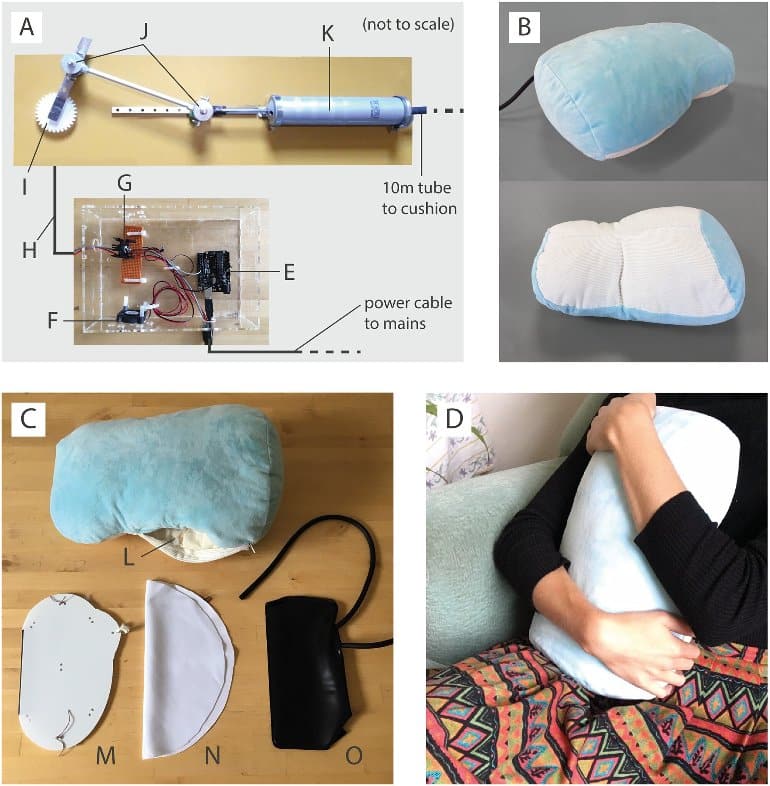Summary: Hugging a novel cushion that mechanically mimics breathing helps reduce anxiety.
Source: PLOS
Researchers have developed a huggable, cushion-like device that mechanically simulates breathing, and preliminary evidence suggests it could help reduce students’ pre-test anxiety. Alice Haynes of the University of Bristol, U.K., and colleagues present the device and findings in the open-access journal PLOS ONE on March 9, 2022.
Treatments for anxiety disorders primarily include therapy and medications. However, these can be costly, and medications may have unwanted side effects. At-home anxiety aids could complement treatments for anxiety disorders and also benefit people experiencing temporary anxiety.
Within this category, a small but growing body of research highlights the anxiety-reducing potential of touch-based devices, such as TouchPoints wearables and Paro the seal, an interactive therapeutic robot.
Now, Haynes and colleagues have developed a new, touch-based device that could ease anxiety. They initially built several prototype devices that simulated different sensations, such as breathing, purring, and a heartbeat. Each prototype took the form of a soft, huggable cushion that was meant to be intuitive and inviting.
Focus group testing identified the “breathing” cushion as being the most pleasant and calming, so the researchers further developed it into a larger, mechanical cushion.
To test the new device, the research team recruited 129 volunteers for an experiment involving a group mathematics test. Using pre- and post-test questionnaires, the researchers found that students who used the device were less anxious pre-test than those who did not. The experiment also compared the breathing cushion to a guided meditation, and found that both were equally effective at easing anxiety.

These findings suggest that the breathing cushion could be used to reduce anxiety, for example for students who are anticipating exams. The researchers now hope to further refine the cushion for testing in people’s homes.
They also plan to investigate people’s physiological response to the device—for instance, changes in heart rate or breathing patterns—in order to elucidate the particular mechanisms by which the device might ease anxiety.
The authors add: “We were excited to find that holding the breathing cushion, without any guidance, produced a similar effect on anxiety in students as a meditation practice. This ability of the device to be used intuitively opens it up to providing wider audiences with accessible anxiety relief.”
About this anxiety research news
Author: Press Office
Source: PLOS
Contact: Press Office – PLOS
Image: The image is in the public domain
Original Research: Open access.
“A calming hug: Design and validation of a tactile aid to ease anxiety” by Haynes AC, Lywood A, Crowe EM, Fielding JL, Rossiter JM, Kent C. PLOS ONE
Abstract
A calming hug: Design and validation of a tactile aid to ease anxiety
Anxiety disorders affect approximately one third of people during their lifetimes and are the ninth leading cause of global disability. Current treatments focus on therapy and pharmacological interventions. However, therapy is costly and pharmacological interventions often have undesirable side-effects.
Healthy people also regularly suffer periods of anxiety. Therefore, a non-pharmacological, intuitive, home intervention would be complementary to other treatments and beneficial for non-clinical groups.
Existing at-home anxiety aids, such as guided meditations, typically employ visual and/or audio stimuli to guide the user into a calmer state. However, the tactile sense has the potential to be a more natural modality to target in an anxiety-calming device.
The tactile domain is relatively under-explored, but we suggest that there are manifold physiological and affective qualities of touch that lend it to the task. In this study we demonstrate that haptic technology can offer an enjoyable, effective and widely accessible alternative for easing state anxiety.
We describe a novel huggable haptic interface that pneumatically simulates slow breathing. We discuss the development of this interface through a focus group evaluating five prototypes with embedded behaviours (‘breathing’, ‘purring’, ‘heartbeat’ and ‘illumination’).
Ratings indicated that the ‘breathing’ prototype was most pleasant to interact with and participants described this prototype as ‘calming’ and ‘soothing’, reminding them of a person breathing. This prototype was developed into an ergonomic huggable cushion containing a pneumatic chamber powered by an external pump allowing the cushion to ‘breathe’.
A mixed-design experiment (n = 129) inducing anxiety through a group mathematics test found that the device was effective at reducing pre-test anxiety compared to a control (no intervention) condition and that this reduction in anxiety was indistinguishable from that of a guided meditation. Our findings highlight the efficacy of this interface, demonstrating that haptic technologies can be effective at easing anxiety.
We suggest that the field should be explored in more depth to capture the nuances of different modalities in relation to specific situations and trait characteristics.







